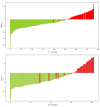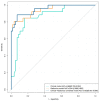MRI-Based Radiomics Nomogram for Predicting Prostate Cancer with Gray-Zone Prostate-Specific Antigen Levels to Reduce Unnecessary Biopsies
- PMID: 36553012
- PMCID: PMC9776817
- DOI: 10.3390/diagnostics12123005
MRI-Based Radiomics Nomogram for Predicting Prostate Cancer with Gray-Zone Prostate-Specific Antigen Levels to Reduce Unnecessary Biopsies
Abstract
Objective: The aim of this study was to establish a predictive nomogram for predicting prostate cancer (PCa) in patients with gray-zone prostate-specific antigen (PSA) levels (4-10.0 ng/mL) based on radiomics and other traditional clinical parameters.
Methods: In all, 274 patients with gray-zone PSA levels were included in this retrospective study. They were randomly divided into training and validation sets (n = 191 and 83, respectively). Data on the clinical risk factors related to PCa with gray-zone PSA levels (such as Prostate Imaging Reporting and Data System, version 2.1 [PI-RADS V2.1] category, age, prostate volume, and serum PSA level) were collected for all patients. Lesion volumes of interest (VOI) from T2-weighted imaging (T2WI) and apparent diffusion coefficient (ADC) imaging were annotated by two radiologists. The radiomics model, clinical model, and combined prediction model, which was presented on a nomogram by incorporating the radiomics signature and clinical and radiological risk factors for PCa, were developed using logistic regression. The area under the receiver operator characteristic (AUC-ROC) and decision, calibration curve were used to compare the three models for the diagnosis of PCa with gray-zone PSA levels.
Results: The predictive nomogram (AUC: 0.953) incorporating the radiomics score and PI-RADS V2.1 category, age, and the radiomics model (AUC: 0.941) afforded much higher diagnostic efficacy than the clinical model (AUC: 0.866). The addition of the rad score could improve the discriminatory performance of the clinical model. The decision curve analysis indicated that the radiomics or combined model could be more beneficial compared to the clinical model for the prediction of PCa. The nomogram showed good agreement for detecting PCa with gray-zone PSA levels between prediction and histopathologic confirmation.
Conclusion: The nomogram, which combined the radiomics score and PI-RADS V2.1 category and age, is an effective and non-invasive method for predicting PCa. Furthermore, as well as good calibration and is clinically useful, which could reduce unnecessary prostate biopsies in patients having PCa with gray-zone PSA levels.
Keywords: MRI; biopsies; prostate cancer; radiomics.
Conflict of interest statement
The authors declare no conflict of interest.
Figures







Similar articles
-
Predicting prostate cancer in men with PSA levels of 4-10 ng/mL: MRI-based radiomics can help junior radiologists improve the diagnostic performance.Sci Rep. 2023 Mar 24;13(1):4846. doi: 10.1038/s41598-023-31869-1. Sci Rep. 2023. PMID: 36964192 Free PMC article.
-
The potential of a nomogram combined PI-RADS v2.1 and contrast-enhanced ultrasound (CEUS) to reduce unnecessary biopsies in prostate cancer diagnostics.Br J Radiol. 2022 Sep 1;95(1138):20220209. doi: 10.1259/bjr.20220209. Epub 2022 Aug 17. Br J Radiol. 2022. PMID: 35877385 Free PMC article.
-
Development and Validation of a Radiomics Nomogram for Predicting Clinically Significant Prostate Cancer in PI-RADS 3 Lesions.Front Oncol. 2022 Jan 26;11:825429. doi: 10.3389/fonc.2021.825429. eCollection 2021. Front Oncol. 2022. PMID: 35155214 Free PMC article.
-
Predicting clinically significant prostate cancer in PI-RADS 3 lesions using MRI-based radiomics: a literature review of methodological variations and performance.Abdom Radiol (NY). 2025 Apr 2. doi: 10.1007/s00261-025-04914-y. Online ahead of print. Abdom Radiol (NY). 2025. PMID: 40172658 Review.
-
Prediction of extracapsular extension of prostate cancer by MRI radiomic signature: a systematic review.Insights Imaging. 2024 Aug 26;15(1):217. doi: 10.1186/s13244-024-01776-8. Insights Imaging. 2024. PMID: 39186182 Free PMC article. Review.
Cited by
-
Comparisons of the diagnostic accuracy across prostate health index, prostate health index density, and percentage free prostate-specific antigen for clinically significant prostate cancer: a prospective diagnostic study.Transl Androl Urol. 2023 Mar 31;12(3):425-432. doi: 10.21037/tau-23-80. Epub 2023 Mar 28. Transl Androl Urol. 2023. PMID: 37032752 Free PMC article.
-
Machine learning based on automated 3D radiomics features to classify prostate cancer in patients with prostate-specific antigen levels of 4-10 ng/mL.Transl Androl Urol. 2025 Apr 30;14(4):1025-1035. doi: 10.21037/tau-2024-731. Epub 2025 Apr 27. Transl Androl Urol. 2025. PMID: 40376513 Free PMC article.
-
Comparison in prostate cancer diagnosis with PSA 4-10 ng/mL: radiomics-based model VS. PI-RADS v2.1.BMC Urol. 2024 Oct 23;24(1):233. doi: 10.1186/s12894-024-01625-2. BMC Urol. 2024. PMID: 39443896 Free PMC article.
-
Radiomic Machine-Learning Analysis of Multiparametric Magnetic Resonance Imaging in the Diagnosis of Clinically Significant Prostate Cancer: New Combination of Textural and Clinical Features.Curr Oncol. 2023 Feb 7;30(2):2021-2031. doi: 10.3390/curroncol30020157. Curr Oncol. 2023. PMID: 36826118 Free PMC article.
-
Predicting prostate cancer in men with PSA levels of 4-10 ng/mL: MRI-based radiomics can help junior radiologists improve the diagnostic performance.Sci Rep. 2023 Mar 24;13(1):4846. doi: 10.1038/s41598-023-31869-1. Sci Rep. 2023. PMID: 36964192 Free PMC article.
References
-
- Roobol M.J., Kranse R., Bangma C.H., van Leenders A.G., Blijenberg B.G., van Schaik R.H., Kirkels W.J., Otto S.J., van der Kwast T.H., de Koning H.J., et al. Screening for prostate cancer: Results of the Rotterdam section of the European randomized study of screening for prostate cancer. Eur. Urol. 2013;64:530–539. doi: 10.1016/j.eururo.2013.05.030. - DOI - PubMed
-
- Chen R., Huang Y.R., Cai X.B., Xie L.P., He D.L., Zhou L.Q., Xu C.L., Gao X., Ren S.C., Wang F.B., et al. Age-Specific Cutoff Value for the Application of Percent Free Prostate-Specific Antigen (PSA) in Chinese Men with Serum PSA Levels of 4.0–10.0 ng/mL. PLoS ONE. 2015;10:e0130308. doi: 10.1371/journal.pone.0130308. - DOI - PMC - PubMed
Grants and funding
LinkOut - more resources
Full Text Sources
Research Materials
Miscellaneous

